How to Make a Lotion for Leg Cramps & Growing Pains
Naturally soothe leg cramps, growing pains, and restless legs with this DIY herb-infused magnesium lotion recipe.
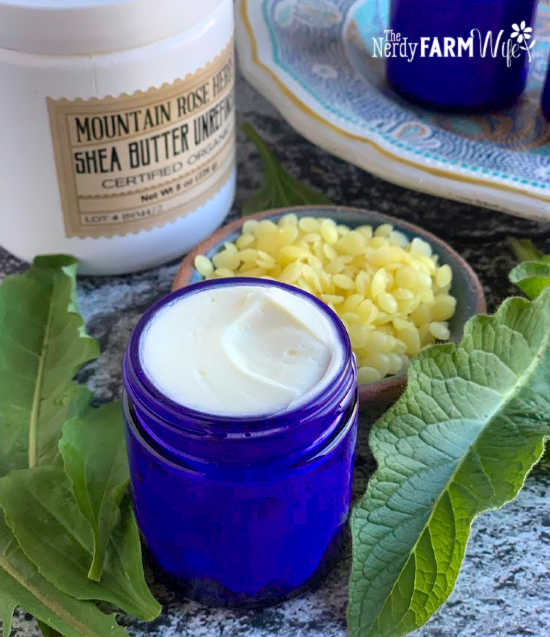
This lotion recipe first came about as a solution to the growing pains my kids develop from time to time.
My son had been experiencing some back pain during a growth spurt (he was 13 and already 5’10”) and my daughter had nightly leg cramps, so our naturopath suggested magnesium oil. It worked wonders on them after only a few applications! (They routinely take supplemental magnesium too.)
However, magnesium oil can be a skin irritant and they both have ultra-sensitive skin, so I wanted to cushion the magnesium oil in a skin soothing lotion or cream containing aloe. I infused oil with arnica, which is helpful for inflammation and joint pain, and comfrey, which can be used to treat sprains, strains, and other sore muscle woes, then rounded out the recipe with a little bit of lavender essential oil, for relaxation, and peppermint essential oil, which is also good for muscle pain. (Plus it makes it smell good!)
So, that’s the story behind the recipe, now let’s get into how you can make it!
You can find all of the ingredients to make this lotion at Mountain Rose Herbs except for the magnesium oil. I buy that from my local health food store, but some brands to look for online include Ancient Minerals and Life-flo, both of which I’ve personally used in this recipe with good success.
Don’t have time to make your own magnesium lotion?
Check out the Magnesium Lotion Shop – they sell a lovely all-natural magnesium lotion, handcrafted in small batches.
Their lotion was created by Mike and Tiffany (from the Don’t Waste the Crumbs blog) when she was struggling with restless leg syndrome after the birth of their second child. Thanks to their carefully crafted formula, she was finally able to get a good night’s sleep! (Check out their 200+ stellar reviews while you’re there!)
Beeswax Cream Video Tip:
Creams that are based on beeswax (instead of an emulsifier) can be tricky to make!
Here’s a video of me making a beeswax-based cream, using a recipe from my Handmade Lotions & Creams eBook Collection. Sometimes an ad plays first, but the video will play right after. If you have an adblocker, the video player won’t show up on your screen.
Lotion for Leg Cramps, Growing Pains & Restless Legs
This recipe is made with beeswax, using the old-fashioned cold cream method, instead of an emulsifier. It creates a thick lotion, or thin cream, depending on how you label your lotions and creams. If you’d prefer using a recipe with emulsifying wax instead of beeswax, please visit my Dandelion Magnesium Lotion recipe or my Stress Relief Lotion recipe.
- 3 oz (85 g) Arnica & Comfrey Infused Oil (see below)
- 1/2 oz (14 g) Beeswax
- 1/2 oz (14 g) Stearic Acid (a natural thickener)
- 1.5 oz (42 g) Shea or Mango Butter
- 1.5 oz (42 g) Magnesium Oil
- 1.5 oz (42 g) Aloe Vera Gel
- optional: 2 tsp (8 g) Arrowroot Powder (to cut oily feel)
- 3 to 4 drops each of Peppermint & Lavender Essential Oils
- Nature-Derived Preservative (see tips section below)
First, you’ll need to make some arnica and comfrey infused oil. (Or, you can buy ready made arnica oil at Mountain Rose Herbs that will work perfectly in this recipe.)
How to Make the Arnica & Comfrey Infused Oil:
To make arnica and comfrey infused oil, add about 2 tablespoons dried arnica flowers and 2 tablespoons dried comfrey in a pint jar. You could also add other herbs that may help aches and pains, such as dandelion and goldenrod. Cover with around six ounces of sunflower, apricot kernel, olive, or your favorite type of carrier oil, until it reaches almost to the top.
The type of oil you use will affect the final lotion/cream:
- Sunflower oil soothes damaged skin, or those with eczema, but absorbs in a little slower than apricot kernel.
- Apricot kernel soaks into your skin quickly and is helpful for dry itchy skin types.
- Olive oil is a classic oil for infusions, but has a heavier feel on your skin, so your lotion might take longer to soak in.
Stir and set the jar down into a saucepan containing a few inches of water, to form a makeshift double boiler. Heat the pan over lowish heat for two to three hours, keeping an eye on the water so it doesn’t evaporate out. Don’t let the oil get too hot or you will deep fry your herbs and ruin the batch!
Alternatively, instead of heating, you can cap the jar of herbs and oil and let it infuse at room temperature for 4 to 6 weeks before using. After sufficient time has passed, strain the finished oil into a clean, dry jar. Shelf life for the oil is about one year, or until it starts smelling off or rancid.
How to Make the Lotion:
Now that the oil is infused, we can proceed with the recipe:
Place the herbal infused oil, beeswax, and stearic acid into a heat proof bowl or pyrex measuring cup.
Set the cup down into a saucepan that has a few inches of water in it. Place the pan over a medium low burner until the beeswax has melted.
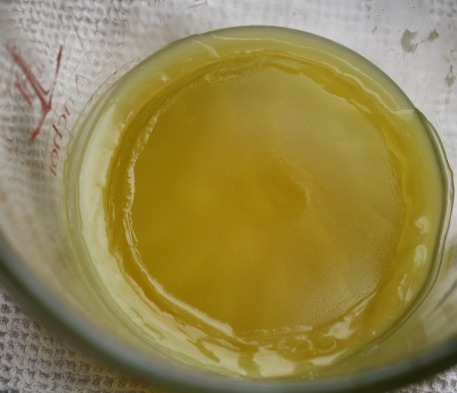
Turn off the heat and stir in the shea or mango butter until melted. (Sometimes, shea butter gets grainy if it overheats, so this step can help with that.) Take the pan off of the burner.
Remove the measuring cup from the pan and set it aside until it cools to around body temperature and develops a light layer on top, where it’s starting to set up, but is still liquid underneath. (See the photo above.)
While the wax mixture is cooling, measure and combine the magnesium oil and aloe vera gel in a separate heat proof jar. Set the jar down into the pan of hot water you used to melt the beeswax for several minutes, to warm it up some. (Remember, the pan should be off of the burner at this point.)
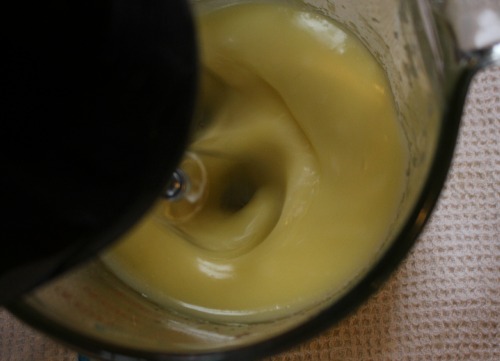
Once your melted oil/wax/shea mixture and magnesium oil/aloe mixture are both around 95 to 100 degrees F, then you’re ready to mix!
Slowly drizzle the magnesium/aloe mixture into the oil while beating with a hand mixer. After about five minutes, stop, add the arrowroot powder (optional, will help cut down on any oily feel that beeswax-based lotions can leave), any essential oils you want to use, and the preservative of choice, then scrape down the sides.
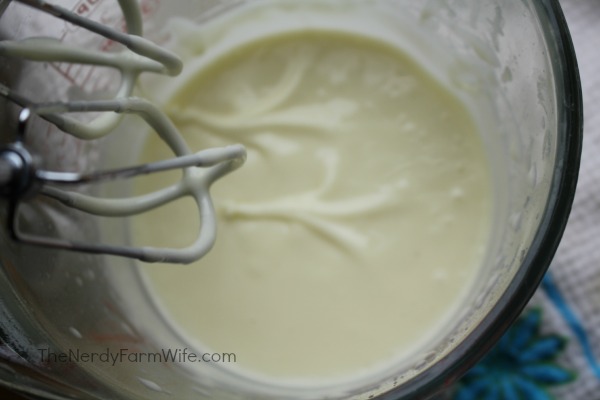
Continue beating another three to five minutes, as the lotion thickens and cools.
When you lift the beaters, you’ll see a very brief imprint where they were, before it sinks quickly back into itself. (See photo above.)
The lotion will be thin at this point, so now’s the time to pour it into any container that you want to keep it in. After it sets up, it will be more like a thick lotion or thin cream. (You can experiment with more liquid and/or less stearic acid in the recipe if you want an even thinner lotion.)
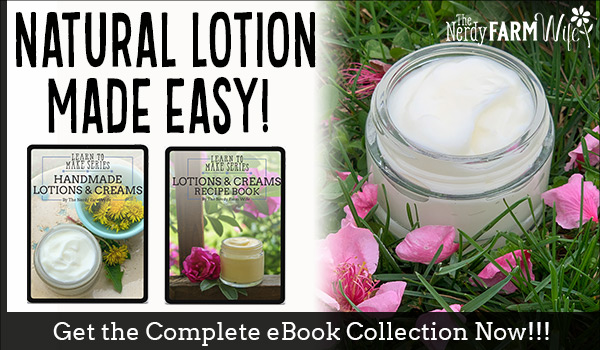
Looking for a complete resource about making safe and effective lotions and creams from scratch?
In my Handmade Lotions & Creams eBook Collection you’ll learn about:
- 45+ oils and butters: their properties, absorbency rates, and benefits.
- emulsifying options to suit your needs: extra easy, organic approved, or unprocessed.
- 30+ herbs and flowers to infuse into oils, aloe, glycerin, or witch hazel.
- 30+ essential oils, their benefits, how to blend them, how much to use.
- over a dozen preservative options {most are natural + a few traditional ones}.
- how to make your own herbal extracts for skin care.
Tips for Making:
Never store lotions or creams containing water-based ingredients (aloe and magnesium oil are both water-based) in metal tins or they could rust or discolor the lotion.
Homemade lotions and creams are a lot more perishable than store-bought. If you don’t add a preservative, make small batches, store in the refrigerator and use this recipe up within a week.
To extend shelf life, add a nature-derived preservative. My current favorite is a combination of 4% Leucidal SF Max, a preservative naturally derived from lactobacillus ferment, plus 2% AMTicide Coconut, for natural mold protection.
To calculate the amount of preservative needed, add up the weight of the ingredients in a recipe by grams, then multiply by the recommended percentage. The total weight of this recipe is 247 grams x 4% (0.04) suggested rate of Leucidal SF Max = 9.9 grams. For AMTicide Coconut it would be 247 grams x 2% (0.02) suggested rate = 4.9 grams, which could be rounded up to 5 grams.
For an even longer shelf life, you could use 2.5 g of Optiphen Plus instead. It’s paraben-free and formaldehyde-free, though not considered strictly natural, but your lotion would still be 99% natural if you use it.
To Use Magnesium Lotion:
Rub a small amount on legs, feet or back before bedtime and at other times during the day, if needed.
Chronic leg cramps can be a sign of other problems too, so if they don’t improve, get yourself checked out by your health care provider.

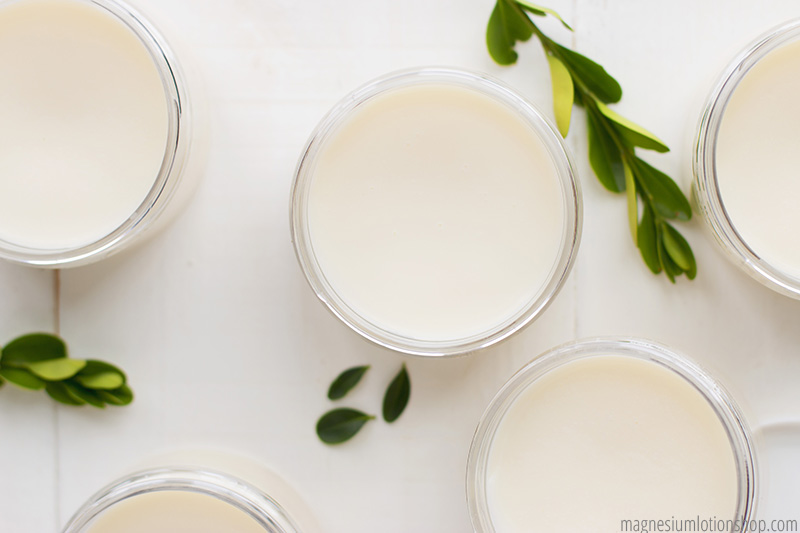
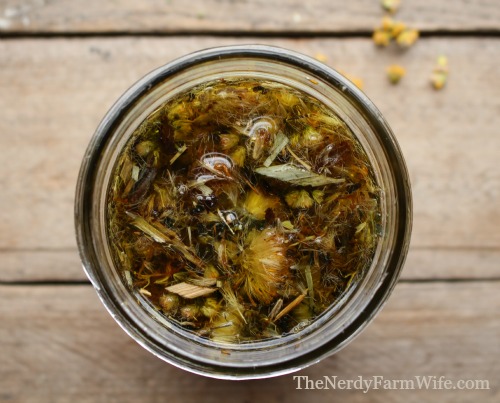
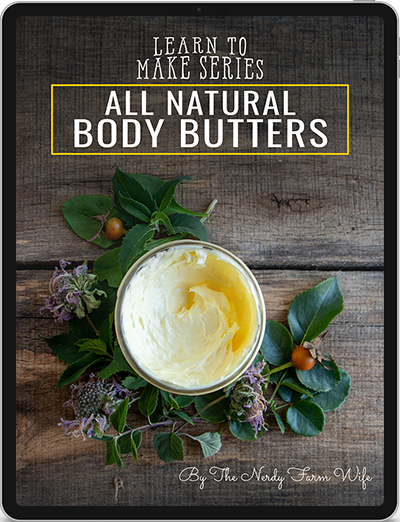

I have never gotten into this area of making things but looks like you know what you are doing. quite interesting
Thanks Terry – It’s a bit of a learning curve to make creams & lotions, but once you get them down pat, they’re a lot of fun to make!
This looks wonderful. I have some arnica oil already infused, so I may try this out. Heaven knows I ache after a day in the garden!
Hi Melanie, I hope you like it! I find it helpful too for using on my neck after I’ve had to sit at a computer for a while, so using it for garden related aches sounds like a great plan!
I like all the ingredients in this lotion but would like to make a body butter instead. Do you have a recipe that would make this thick enough for a butter?
Hi Jeanne! To make it thicker, you could try reducing the liquid even further and increasing the amount of beeswax by half or maybe even a whole tablespoon. If you’d really like the benefits of magnesium to stay, then you could try completely dropping the aloe (since there are other skin soothing ingredients in the recipe.) That’s what I would do as a first test batch and then tinker around with it from there!
I would love to make this lotion. Do you have a recommended source for dried arnica flowers and comfrey leaves? Thanks!
Hi Vicki! I buy almost all of my dried herbs from MountainRoseHerbs.com or BulkHerbStore.com. Mt Rose has a larger selection, so you might want to check there first.
I am allergic to Shea butter. What would you recommend I could use in place of it?
Hi Margarita! You could try mango butter or perhaps avocado butter instead. (You can find mango at MountainRoseHerbs.com and both types at BrambleBerry.com)
Think I could use coconut oil instead of Shea butter? Might need more beeswax?
Hi Rhea! I usually count coconut oil as a liquid oil instead of butter when it comes to substitutions, so I’m just not sure how it would do. You’d have to do some experimenting and tinkering to get the texture you want. More beeswax might work or perhaps less liquids. I think though that it would work, with some adjustments. This is a fairly thick lotion to start with, so you have some room to play!
My son and I are allergic to aloe. Is it needed to make this? Is there something else I could use instead?
Hi Victoria! I haven’t tried it, but I believe there’s enough other skin soothing ingredients in the recipe, where you could replace the aloe with distilled water instead.
I use doTerra lemon grass and fractionated coconut oil when I get a muscle spasm at night. It takes it away immediately. Just a few drops of doTerra Lemon Grass with about a 1/2 tsp doTerra fractionated coconut oil mixed in my hand and I rub it on and voila’ it’s gone. :)
Thanks for the tip Beth! I love the scent of lemongrass, so I bet it smells AND feels great!
Hi Jan,
Could I used tapioca starch instead of arrowroot to cut the oily feeling? I have that on hand…..
Hi Jae! Yes, you sure can. In fact, I think tapioca starch is supposed to work better than arrowroot. I ran out of tapioca starch quite a while back, so have been using arrowroot instead and kind of forgot it existed! I’ll try to go in today and update the post to reflect the substitution note. Thanks for asking and the reminder!
I suffer from “anxiety” in my shoulders at night. I think some folks refer to this as growing pains in children. Would this lotion be effective for treating this or would you recommend something else ? Thanks in advance.
Hi John! I think it’d be worth a shot to try. I have a friend that uses another version of this lotion that I make on her back after a day of gardening and says it helps her tremendously. You might want to look into magnesium supplements too. I hope that you’re able to find relief for your symptoms!
Wondering if I could use the Rosemary Antioxident for the preservative?
Hi Dorn! There’s a bit of conflicting information out there, but it seems the consensus is that rosemary antioxidants work to help prevent rancidity in oils, so increase shelf life that way, but won’t really address mold or bacteria that can grow in the water portion of lotions.
Thank you very much. I just love your website and all of your knowledge!! =^.^=
Thank you! :) Happy to help!
Forgot to ask; How much of the NataPres would I use in your recipe if made the lotion using the amounts listed above? Thanks again. =^.^=
Hi Dorn, Thanks for asking – I forgot to add that part! You’ll want to add 5 grams of NataPres to the recipe. I just updated the post to reflect that information. :)
“To extend shelf life, add a nature-derived preservative, such as NataPres (made from a radish root ferment filtrate with honeysuckle and aspen bark extracts) or Leucidal Liquid SF (a probiotic-based ingredient created by the fermentation of Lactobacillus). The suggested rates of usage are 2% for NataPres or 2 to 4% for Leucidal Liquid SF. To calculate the amount of preservative needed, add up the weight of the ingredients in a recipe by grams, then multiply by the recommended percentage. The total weight of this recipe is 247 grams x 2% (.02) suggested rate = 4.94 grams. I just round that to 5 grams of preservative.”
hi Jae. And, how long would the product last if i add that LL SF preservative? And, would the shelf life of all products be same with it?
Hi Umidakhon! The Leucidal Liquid SF has kept my lotions & creams fresh for at least 3 to 4 months in my personal tests. It may last even longer, but I find that I use things up before then to know for sure. It should have a pretty similar shelf life in other products, depending on their makeup. (If you use something with an herbal tea, it will probably spoil well before something made with distilled water.)
Thank you for that recipe. I want to try this it but without the magnesium oil. Instead I would like to infuse different kind of herbs which have similar properties. Can I just skip the magnesium oil? And would I need to change any thing else regarding quantity because of that?
Thank you.
Hi Silke! You should be able to substitute water (or more aloe) directly for the magnesium oil and make the recipe the same otherwise.
As an alternative idea for you (and future comment readers), I’m currently making a version of this using emulsifying wax instead and really like that too.
If anyone wants to try that, take the base of this recipe:
https://thenerdyfarmwife.com/basil-anti-aging-face-cream/
but adapt it to the ingredients in this Lotion for Leg Cramps & Growing Pains.
So, for that version you could try:
75 g liquid (water OR a blend of magnesium oil, aloe & water OR a blend of aloe & water)
17 g herbal-infused oil (arnica, comfrey, dandelion, or other herbs for aches & pains)
8 g Emulsifying Wax NF
optional – 1 to 4 g of a nature-derived preservative
peppermint & lavender essential oils
Thank you so much Jan! I will definitely take a closer look to that recipe too. Really excited to try one of them.
hi! Could I use vit e as a preservative? And is there an alternative to stearic acid? Thank you:)
Hi Cherie! Vitamin E is a great antioxidant, that will keep oils from going rancid as quickly, but unfortunately, it won’t kill mold or bacteria. I haven’t tried this recipe without the stearic acid (which helps it thicken up nicely). I do however, have a few lotion recipes, that you could adapt to include magnesium oil – to get the health benefits it offers.
This one has beeswax, but no stearic acid:
https://thenerdyfarmwife.com/aloe-mint-lotion/
(instead of 1/4 cup mint tea, you could try 1/4 cup magnesium oil, you can also use shea/mango/cocoa or avocado butter)
OR
I have this one that uses emulsifying wax, instead of beeswax:
https://thenerdyfarmwife.com/lavender-plantain-lotion/
and instead of 5.5 tablespoons (75 ml) distilled water, use magnesium oil (or part magnesium oil and part aloe OR part magnesium oil and part water.)
OR
if you find another lotion recipe you like, you can always sub the magnesium oil for any or all of the water part of it.
I hope that helps give you some ideas! :)
Thank you:) !!!
Hi I have been making magnesium lotion for over a year using emulsaifying wax and stearic acid. So I decided to use beeswax and borax for the second time and once again the lotion separated..I dont understand it..I try to fix it 3 times and it can be so frustrating..I have done it with just plain distilled water and this never happened. What cause the separation?
Thank you.
Hi Karina! I agree that emulsifying wax is SO much easier than using beeswax & borax. I’ve found that if a lotion separates (with beeswax/borax), then try almost doubling the borax amount next time. Also, when using beeswax instead of e-wax, getting the temperature of the oil portion and the water potion to be almost exactly the same will help tremendously. I usually go for the oils and water being close to body temperature (I actually measure it with a digital thermometer that you’d use to check a kid for a fever) and try to have them within maybe 3 or 4 degrees of each other, max. A few times I’ve tried to speed through and mixed before the oils cooled enough and ended up with a mess. I’ve gotten to where I really prefer emulsifying wax these days because it’s a lot higher success rate! You can use any lotion recipe with it that you like, and just use magnesium oil & aloe in the place of water and if you’d like, an infused oil in place of the plain oil.
Loved the article on leg cramps
I’m happy you liked it! :)
This is the best magnesium lotion ever. I make it for my friends and family and it relieves all sorts of aches and pains. I use pure arnica and comfrey oils and sometimes substitute kawa kawa infused oil for the arnica. This is a plant the Maori people use for its healing properties.thank you thank you.
Hi Kaaren! So happy that you like the magnesium lotion recipe! :) I’ll have to check out kawa kawa – that’s new to me, but sounds very interesting!
Hello Ms. Jan, I realize this is an older article but I wanted to thank you for this recipe & I can’t wait to try it. I also wanted to add for you & your readers that when my kiddo was younger, starting age 2 or so, had terrible growing pains in the legs. So we used to use the calcium chews.
The generic ones had the same amount of calcium as the name brand ones & were much cheaper. It was an “after dinner treat” or dessert before brushing teeth at night. These chews come in chocolate-our preferred flavor-& caramel & can be cut in half or quarters as needed for chewing purposes. We did this for years until being old enough to understand how to swallow pills. Milk was always the primary choice of drink in our house but growing pains in children is normally due to needing more calcium. Growing bones in children act the same as a pregnant woman who needs more calcium-it will be pulled from the teeth. At any rate, the average person, children especially, just do not get enough calcium so a supplement is never a wrong answer. Just thought I’d share this bit of knowledge. I learned a lot during appointments with dieticians & nutritionists.
Hello and thanks for sharing the tips! Calcium is definitely important, along with magnesium, and I believe I forgot to mention in this article – vitamin D & K to make sure the calcium goes to the right places! :)
Hi!
How many mg of magnesium would be in this batch?
Thanks so much!
Hi Stacey! That’s a great question!
I’ve never tried to calculate that number, but I think you should be able to check the label on your bottle of magnesium oil to calculate how many mg of magnesium are in 1.5 oz of that oil.
That should hopefully give you a good idea of how much there is in a batch. :)